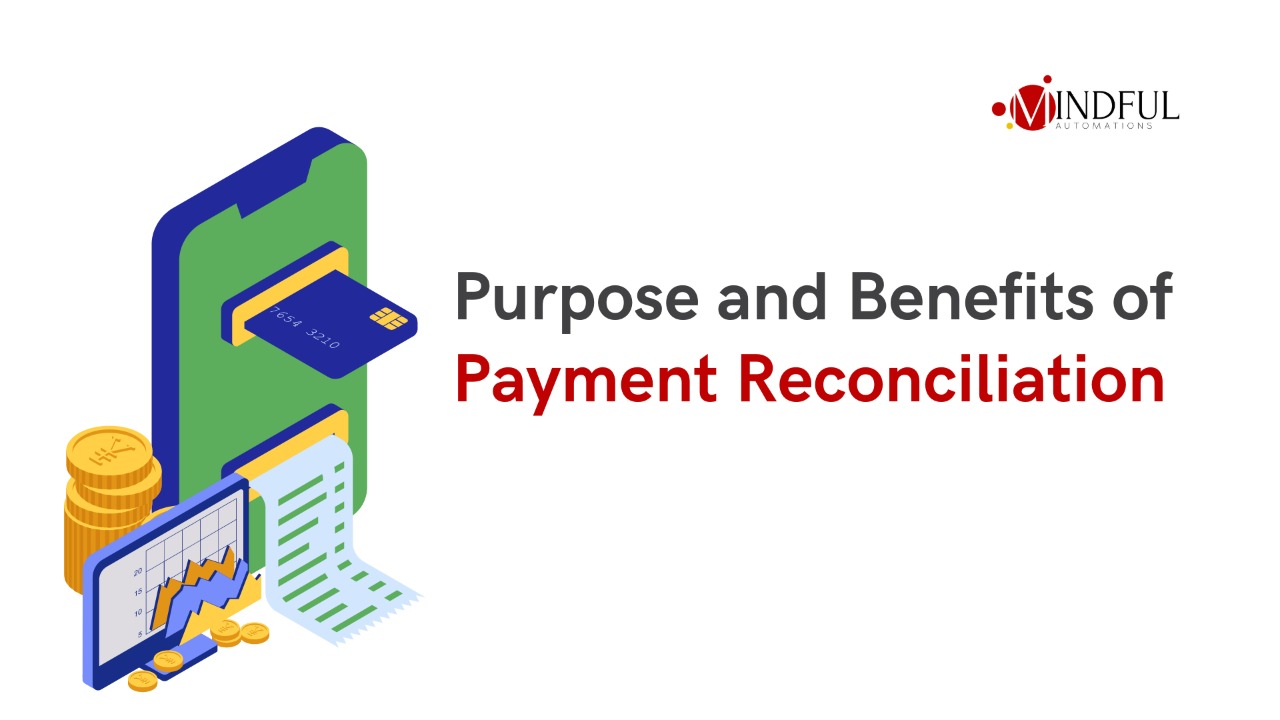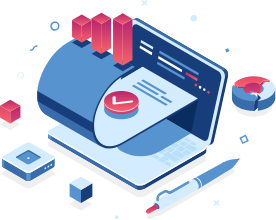As an organization undergoes expansion and growth, it invariably
encounters a surge in operational demands. This escalation in
workload can precipitate an array of challenges, which, if left
unaddressed, may yield detrimental consequences. Among the
prevalent issues that organizations may confront are: a
proliferation of repetitive manual tasks, an upswing in
operational expenditures, susceptibility to human errors during
data handling, potential customer service deficiencies, elevated
rates of employee attrition, and others.
Robotic Process Automation (RPA) emerges as a salient and
strategic solution to mitigate many of these challenges. By
orchestrating the automation of the aforementioned tasks, RPA
offers organizations the ability to facilitate seamless
scalability.
What is Robotic Process Automation?
Robotic process automation is a technology where software bots
are built to mimic human actions in order to perform the
sequence of rule-based repetitive tasks without any human
intervention, Examples: data entry, web scrapping, Invoice
processing, sales orders, payment reconciliations, etc. “RPA is
a promising new development in business automation that offers a
potential ROI of 30–200 percent—in the first year”.
McKinsey White Paper: The next acronym you need to know
about RPA (robotic process automation)
“The relationship between technology and people has to change in
the future for the better, and I think RPA is one of the great
tools to enable that change”.
Leslie Willcocks, professor of technology, work, and
globalization at the London School of Economics
How can robotic process automation add value to your business?

Lowering of errors
When completing repetitive jobs, humans are especially
prone to making mistakes. High-precision task execution
by RPA bots lowers the possibility of errors and
expensive blunders.

Scalability
Depending on business requirements, RPA can be simply
scaled up or down. To ensure optimal resource use, you
can deploy more bots to manage greater workloads during
busy times and deactivate them during quiet times.

Enhanced Adherence/compliance
RPA can be programmed to adhere to stringent compliance
guidelines. This lessens the possibility of
noncompliance and aids in maintaining audit trails for
legal requirements.

Superior Client Service
RPA frees up your human personnel to concentrate on more
complicated, customer-facing jobs by automating routine
chores. This may result in enhanced client satisfaction
and service.

Data reliability
Data correctness is important for decision-making, and
RPA can extract and process data from a variety of
sources, assuring data consistency and quality across
systems.

Faster Response Times
Faster Response Times
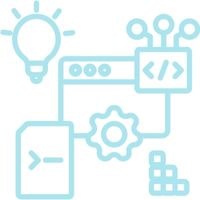
Integration
RPA may interface with currently used programs and
systems, bridging the gap between legacy and
contemporary technologies. The interchange of data is
streamlined by this integration.

Analytics and insights
As RPA completes tasks, it produces useful data. This
data can be examined to learn more about how efficiently
processes operate, spot bottlenecks, and implement
data-driven improvements.
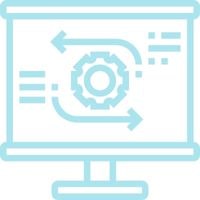
Business Continuity
By managing crucial operations, RPA can assure business
continuity even in the case of unforeseen disasters or
disruptions, like a pandemic or natural disaster.

Return on investment
While there is a one-time expenditure required to use
RPA, the potential for cost savings and efficiency
improvements frequently yields a positive ROI over time.
RPA can be adopted without disrupting the usual business system
The architecture of RPA ensures that it supports the current
business process without causing any disturbance or difficulty.
Yes, one of the main benefits of RPA is that it can be
implemented without upsetting the regular operations of a firm.
Here is how RPA does it:
-
Non-Invasive Integration: Just like human
users, RPA bots communicate with current systems and
applications through their user interfaces. They don't need
the underlying systems or databases altered. This means that
you can adopt RPA without substantially changing your
current IT architecture.
-
No Need for IT Overhaul: Since RPA is often
installed as a layer on top of already-existing systems, you
don't need to start from scratch with your IT
infrastructure. Particularly useful for businesses with
expensive or difficult-to-replace systems.
-
Quick Deployment: Compared to conventional
software development projects, RPA systems may be designed
and deployed quite fast. Bots enable quick process
automation because they can be set up and running in a
matter of weeks.
-
Low User Impact: RPA bots operate in the
background, frequently on devoted servers or virtual
computers. They don't hinder human workers from doing their
jobs. Users can carry on using their systems and
applications as usual.
How does Robotic Process Automation work?
Robotic Process Automation (RPA) is a general term for a set of
procedures and activities carried out by software robots (RPA
bots) to automate operations inside a business process.
Here is a brief description of how RPA generally operates:
-
Initialization: The automation procedure
is launched by activating the RPA bot. This trigger could be
a predetermined time, an occasion, or a manual operator
action.
-
Access and login: If necessary, the bot
launches the requisite user interfaces (such as web browsers
or desktop programs) in order to access the pertinent
programs, systems, or databases.
-
Data Retrieval: The bot gathers information
from a variety of places, such as databases, files,
websites, or other programs. Typically, this data extraction
is carried out by simulating actions that a human user could
take, such as exploring online pages, completing forms, or
using APIs.
-
Task Execution: The individual duties
inside the process are carried out by the bot. These duties
could include data entry, data extraction, report
production, email sending, and other activities. To carry
out these duties, the bot communicates with the target
systems and applications.
-
Data Storage and logging: In addition to
keeping records of the bot's activity, data may need to be
saved in databases or files. With a record of the automated
process in place, auditing and troubleshooting are made
possible.
-
Communication and Task Completion: As part
of the process, the bot may communicate with other systems,
apps, or stakeholders. This can entail creating reports,
sending emails, or updating databases. Until the entire
procedure is finished or the specified conditions for
termination are satisfied, the bot keeps working on tasks.
-
Reporting and Analytics: The performance of
the bot, including execution times, mistake rates, and
productivity indicators, can frequently be tracked using
reporting and analytics services offered by RPA platforms.
Process improvement can benefit from these revelations.
-
Completion and Shutdown: The bot signs off
from applications, saves any necessary data or reports, and
shuts down whenever the automation process is complete or
when it reaches the specified endpoint.
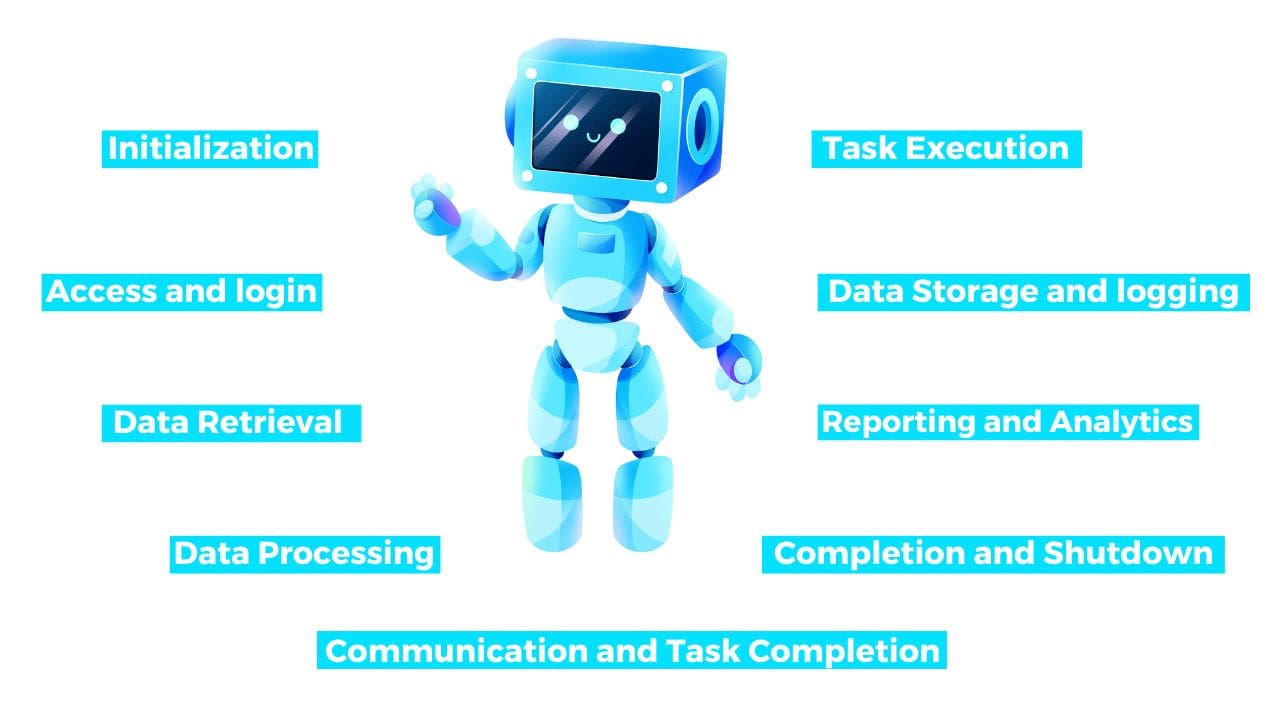
What are the different types of RPA?
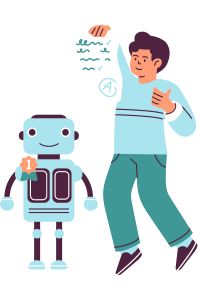
Attended bots
Attended bots are a form of Robotic Process Automation (RPA)
in which software robots (bots) work alongside human
employees to automate and assist with tasks. Unlike
unattended RPA, which operates independently without human
intervention, attended bots are designed to collaborate
directly with human workers in real time.

Unattended bots
Attended bots are a form of Robotic Process Automation (RPA)
in which software robots (bots) work alongside human
employees to automate and assist with tasks. Unlike
unattended RPA, which operates independently without human
intervention, attended bots are designed to collaborate
directly with human workers in real-time.

Hybrid Bots
Hybrid bots typically refer to a combination of both
attended and unattended bots within an organization. It's an
approach that leverages the strengths of both attended and
unattended bots to optimize automation across various
processes.
FAQ -Frequently Asked Questions
Q1. What are the important characteristics of RPA?
- Code Free.
- User-friendly.
- Non-disruptive.
Q2. What is process mining?
Process mining is a data-driven approach for analyzing event
logs to understand, monitor, and improve organizational
processes. It uncovers insights into how processes are actually
executed, aiding in optimization and compliance monitoring.
Q3. What are the steps involved in RPA implementation?
Step 1- Process mining
Step 2- Develop business case
Step 3- decision on automation operating model
Step 4- finding an automation partner
Step 5- determining automation roadmap















